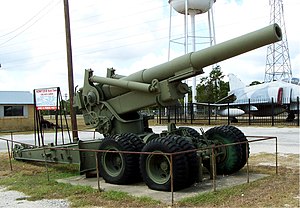M115 howitzer
| M-115 203 mm howitzer | |
|---|---|

A M-115 203 mm howitzer on display at Bastrop, Texas, United States.
|
|
| Type | Howitzer |
| Place of origin | United States |
| Production history | |
| Designed | 1939 |
| Specifications | |
| Weight | 14,515 kg (31,780 lbs) |
| Length | 10.972 m (40 ft) |
| Barrel length | 5.14 m (16 ft 10 in) |
| Crew | 14 |
|
|
|
| Shell | 90.7 kg (200 lb) |
| Caliber | 203 millimetres (8.0 in) |
| Breech | Interrupted screw |
| Recoil | Hydropneumatic |
| Carriage | Split trail |
| Elevation | −2° to +65° |
| Traverse | +60° |
| Rate of fire | 1 rpm (maximum) 3 rounds per 2 minutes (maximum) |
| Muzzle velocity | 587 m/s (1,926 ft/s) |
| Effective firing range | 16,800 m (18,373 yds) |
The M115 203 mm howitzer, also known as the M115 8 inch howitzer, was a towed howitzer developed and used by the United States Army. Until the 1950s it was designated the 8 inch Howitzer M1. The original design started in 1919 but lapsed until resurrected in 1927 as a partner-piece for a new 155 mm gun. It was standardized as 8 inch Howitzer M1 in 1940. The M115/M1 was towed by the M35 Prime Mover gun tractor or a Mack 7⅓ ton 6×6 truck. The M115 was towed with 21 men per gun, and was shipped over to Germany Oct 1961 in response to the Berlin Crisis.
Like the British BL 8 inch Howitzer of the First World War, the M115 uses a Welin screw for its breech. The carriage was the same as used for the US 155 mm gun and was also adopted by the British for their 7.2 inch Mark 6 howitzer. It consists of equilibrator assemblies, elevating and traversing mechanisms, two single-wheel, single-axle heavy limber, and a two-axle bogie with eight tires and two trails. Four spades, carried on the trails, are used to emplace the weapon. The British 8 inch howitzer was produced in England and under license in the US, for the American Expeditionary Forces in Europe during World War I, as the 8-inch Howitzer MK. VI. It was in service with the US Army till replaced by the M115. There are no reports of the MK. VI or another marks being used during World War II.
The first photos of the M115 type 8 inch cannon on its redesign carriage appeared in 1931 but development was slowed by the Great Depression.
The M115 saw U.S. service in World War II, the Korean War, and the Vietnam War. In the late 1950s, it was adopted in small numbers by several NATO armies, to fire the W33 (M454 shell) and later the W79 nuclear artillery shell, under the NATO nuclear sharing concept, a role which ended when the smallest types of tactical nuclear weapons were removed from service and eliminated. It was also adopted as a field weapon by a number of nations in Europe, the Middle East, and Asia and saw service in the Second Taiwan Strait Crisis and the Croatian War of Independence.
...
Wikipedia
